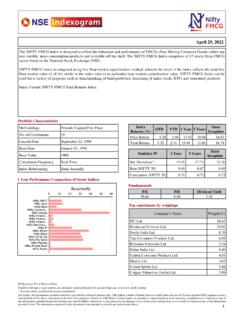Transcription of Furniture - IBEF
1 FurnitureMARKET & OPPORTUNITIESCONTENTSI ntroduction 2 Indian Furniture Industry 3 Appendix 11A report by KPMG for IBEFF urnitureMARKET & OPPORTUNITIESMARKET & OPPORTUNITIES2 IntroductionThe global Furniture market can be broadly categorised into four categories - domestic Furniture , office/corporate Furniture , hotel Furniture and Furniture parts. Globally, domestic Furniture accounts for 65 per cent of the production value, whilst corporate/office Furniture represents 15 per cent, hotel Furniture 15 per cent and Furniture parts 5 per cent. According to a World Bank study, the organised Furniture industry is expected to grow by 20 per cent every year.
2 A large part of this growth is expected to come from the rapidly growing consumer markets of Asia, implying significant potential for growth in the Indian Furniture sector. 65%5%15%15%Global Furniture Marketn Domestic n Office n Hotel n PartsSource: KPMG Analysis for IBEFI ndian Furniture IndustryAs of 2006, the Indian Furniture market is estimated to be worth US$ 7,922 million. Of this, wooden Furniture accounts for US$ 1,358 million. About 11 per cent (US$ 152 million) of this (wooden Furniture ) is imported and imports are growing at 50 to 60 per cent every year. India was the largest Furniture importer in the world in 2004-05, with a 17 per cent share in the Furniture imports worldwide.
3 A total of 10, 476 importers shipped Furniture to India during this period, mainly from Italy, Germany, Spain, China, Korea, Malaysia, Indonesia, Philippines and Japan. The Furniture sector in India makes a marginal contribution to the Gross Domestic product (GDP), representing about per cent of the total GDP. The major part of this industry, approximately 85 per cent is in the unorganised sector. The remaining 15 per cent comprises of large manufacturers, such as, godrej & Boyce Manufacturing Co. Ltd., BP Ergo, Featherlite, Haworth, Style Spa, Yantra, Renaissance, Millennium Lifestyles, Durian, Kian, Tangent, Furniture Concepts, Furniturewala, Zuari, Truzo, N R Jasani & Company, V3 Engineers, PSL Modular Furniture , range of indigenous Furniture available in India, includes both residential and contract system Furniture .
4 Manufacturers in India usually use a three-tier selling and distribution structure, comprising of the distributor, wholesaler and retailer. The market is mainly concentrated in A, B and C category cities (the top 589 cities). A and B type cities together constitute 33 per cent of the total market. With a healthy economy and increased household and institutional spending, the market is growing steadily. Furniture I NdUSTRy COMPOSITIONAs with the global market, home Furniture is the largest segment in the Indian Furniture market, accounting for about 65 per cent of Furniture sales. This is followed by, the office Furniture segment with a 20 per cent share and the contract segment, accounting for the remaining 15 per cent.
5 N Household n Office n ContractConsumer Segments15%65%20%Share of Organised and Unorganised Sectors (US$ Billion, Percentage Share)n Unorganised n Organised Source: KPMG , 15% , 85%F U R N I T U R EMARKET & OPPORTUNITIES4 Home furnitureHome Furniture in India is available in a wide range, to cater to different customer needs. A typical middle class urban Indian home has five rooms (including kitchen and bathroom). About 25 per cent of the urban population live in homes with five rooms or more, while 45 per cent live in houses with three rooms or less. About 16 per cent is estimated to live in single-room homes. The type of Furniture used depends on the customer s affluence and rich and upper middle class is typically very attentive to design and quality, so price is rarely a determining factor.
6 In general, European style Furniture is only found in homes of the urban upper class. Demand for Furniture of international standards is limited to the larger cities. It is also estimated that the wealthier classes do not change Furniture very frequently; the average life of a piece of Furniture is about 20 years and some craftsmen s pieces are used for as long as 50-70 years. Colonial Furniture is still very common in India, but the trend seems to be declining slowly. Office FurnitureThe office Furniture segment caters to the commercial and office space. This segment has witnessed rapid growth in recent years, in line with the growth in the Indian economy and subsequent demand for office space.
7 The thrust on real estate and office construction is expected to sustain in the near future, indicating continued growth for the Furniture segmentThe contract segment caters primarily to hotels and its growth is consequently linked to growth in tourism and development of new hotels. There are around 1,200 hotels in India in the organised sector. More than 10 per cent of these are in the 5-star and above categories (please refer to table below for details).Star CategoryNo. of HotelsNo. of Rooms5 - Star Deluxe9721,3145 - Star829,5054 - Star1147,6063 - Star42719,1642 - Star1815,1481 - Star522,682 Heritage853,4453 - Star Apartment Hotel21104 - Star Apartment Hotel1445 - Star Apartment Hotel1100 Silver Incredible India Bed & Breakfast Establishment26 Gold Incredible India Bed & Breakfast Establishment36To be classified1227,657 Total1,16975,787 Category - wise Availablity of Hotel RoomsSource: Annual Report 2006-07, Department of Tourism5F U R N I T U R ESuppliersManufacturersWholesalersRetail ersImportersOrganised Sector Value ChainTourism in India is growing at a robust pace.
8 The number of foreign tourists has increased over the last three years, as indicated in the figure trends indicate significant potential for growth in the contract Furniture sum it up, the Furniture market in India is growing on strong fundamentals, with demand drivers likely to sustain over the medium term. At the same time, the supply side is also encouraging, as India has sufficient availability of key raw materials that are used as inputs for Furniture I NdUSTRy VAlUE CHAINThe Indian Furniture industry covers the entire gamut of activities, from sourcing, manufacturing and distribution, to sales and after sales. In the Indian context, players are actively engaged in each of these types of raw materials are used for Furniture making in India.
9 The key raw materials include wood, metal and plastic, with bamboo and cane also being used in some cases. Wood accounts for nearly 65 per cent of all Furniture made in India. This includes several types of indigenous wood, as well as imported wood. India imports wood from various South East Asian countries such as Indonesia, Malaysia and Myanmar. It also imports MDF (Medium Density Fibreboard) boards from India abounds in several tree species whose wood is used for Furniture making. Apart from indigenous material available in India, some types of wood are also imported, in case the domestic supply is inadequate. Popular wood types used in India include Walnut, Sandalwood, Teak, Sheesham, Deodar, Ebony, Redwood, Rosewood, Red Cedar and Sal.
10 Teak accounts for almost 50 per cent of the total wooden Furniture produced, Sal and Deodar account for about 20 per cent and the balance includes Mahogany, Cedar and other tree types. Bamboo Material Boards (BMB) are increasingly being used in place of plywood. India also has abundant rubber wood supply. Natural rubber plantations cover 520,000 hectares with an additional 6,000 hectares being replanted almost every year since 1994. The southern state of Kerala produces 95 per cent of the total supply of rubber wood in India. Although Furniture making as an Foreign Tourist Arrivals2006200520043,4583,9194,44705,00 04,0003,0002,0001,000 CAGR ( 000s)n Wood n Metal n Plastic 10%65%25%Raw Material UsageMARKET & OPPORTUNITIES6activity is spread across the length and breadth of India, a few centres have become famous for their exquisite carving, inlaying, turning and lacquering.













